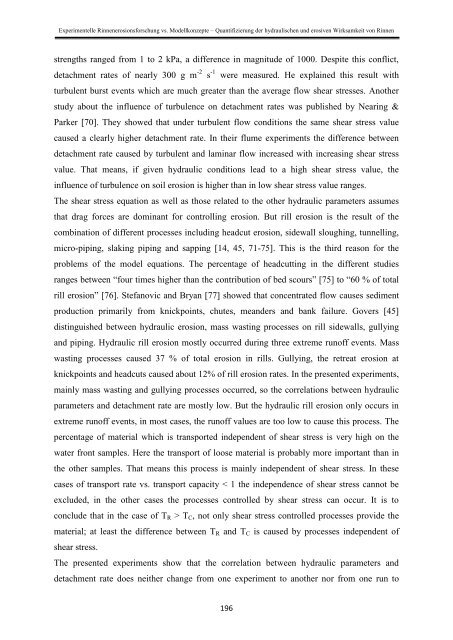Stefan Wirtz Vom Fachbereich VI (Geographie/Geowissenschaften ...
Stefan Wirtz Vom Fachbereich VI (Geographie/Geowissenschaften ...
Stefan Wirtz Vom Fachbereich VI (Geographie/Geowissenschaften ...
Create successful ePaper yourself
Turn your PDF publications into a flip-book with our unique Google optimized e-Paper software.
Experimentelle Rinnenerosionsforschung vs. Modellkonzepte – Quantifizierung der hydraulischen und erosiven Wirksamkeit von Rinnen<br />
strengths ranged from 1 to 2 kPa, a difference in magnitude of 1000. Despite this conflict,<br />
detachment rates of nearly 300 g m -2 s -1 were measured. He explained this result with<br />
turbulent burst events which are much greater than the average flow shear stresses. Another<br />
study about the influence of turbulence on detachment rates was published by Nearing &<br />
Parker [70]. They showed that under turbulent flow conditions the same shear stress value<br />
caused a clearly higher detachment rate. In their flume experiments the difference between<br />
detachment rate caused by turbulent and laminar flow increased with increasing shear stress<br />
value. That means, if given hydraulic conditions lead to a high shear stress value, the<br />
influence of turbulence on soil erosion is higher than in low shear stress value ranges.<br />
The shear stress equation as well as those related to the other hydraulic parameters assumes<br />
that drag forces are dominant for controlling erosion. But rill erosion is the result of the<br />
combination of different processes including headcut erosion, sidewall sloughing, tunnelling,<br />
micro-piping, slaking piping and sapping [14, 45, 71-75]. This is the third reason for the<br />
problems of the model equations. The percentage of headcutting in the different studies<br />
ranges between “four times higher than the contribution of bed scours” [75] to “60 % of total<br />
rill erosion” [76]. <strong>Stefan</strong>ovic and Bryan [77] showed that concentrated flow causes sediment<br />
production primarily from knickpoints, chutes, meanders and bank failure. Govers [45]<br />
distinguished between hydraulic erosion, mass wasting processes on rill sidewalls, gullying<br />
and piping. Hydraulic rill erosion mostly occurred during three extreme runoff events. Mass<br />
wasting processes caused 37 % of total erosion in rills. Gullying, the retreat erosion at<br />
knickpoints and headcuts caused about 12% of rill erosion rates. In the presented experiments,<br />
mainly mass wasting and gullying processes occurred, so the correlations between hydraulic<br />
parameters and detachment rate are mostly low. But the hydraulic rill erosion only occurs in<br />
extreme runoff events, in most cases, the runoff values are too low to cause this process. The<br />
percentage of material which is transported independent of shear stress is very high on the<br />
water front samples. Here the transport of loose material is probably more important than in<br />
the other samples. That means this process is mainly independent of shear stress. In these<br />
cases of transport rate vs. transport capacity < 1 the independence of shear stress cannot be<br />
excluded, in the other cases the processes controlled by shear stress can occur. It is to<br />
conclude that in the case of T R > T C , not only shear stress controlled processes provide the<br />
material; at least the difference between T R and T C is caused by processes independent of<br />
shear stress.<br />
The presented experiments show that the correlation between hydraulic parameters and<br />
detachment rate does neither change from one experiment to another nor from one run to<br />
196
















